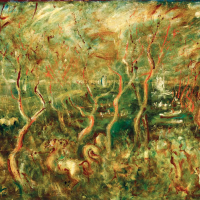WILLIAM DOBELL

An important late work, Colour Abstract (Scene on the Harbour) 1960 encapsulates a defining moment within Dobells career. A keynote to his celebrated later style, the work delicately depicts the harbour at Wangi. Wangi was a special place for Dobell, initially providing refuge after the controversy of his 1943 Archibald Prize portrait of Joshua Smith. It was during this first extended stay at Wangi that Dobell favoured landscapes rather than portraiture as he could freely express the sensation of the subject without the added pressure of pleasing the sitter.1
Wangi remained a subject for his painting, and he often returned to this familiar outlook to capture its atmosphere in fleeting moments. Dobell transferred his vivid portrayal of character and his ability to capture the intimate details of a portrait to landscapes, allowing these attributes to become hallmarks of his work. James Gleeson notes that at this point in his career, Dobells interest lay in seizing a particular movement, extending it through the composition until the whole painting pulsated with rhythm.2 Dobells residence at Wangi sat on the foreshores of Lake Macquarie looking north. A sunny terrace shaded by a Jacaranda tree and a little path were the only things that separated the house from the waterline. The tranquillity of this scene was rarely disturbed, if only by a westerly, or winds howling from the nor-east, which sent the lake into a sensation of vibrant chaos.
Dobells Colour Abstract (Scene on the Harbour) is a whimsical portrayal of Wangi. The contorted tree trunks jut vertically and sporadically throughout the composition leading into a sky that is rife with the promise of a storm. Peeking through the foliage, the usually calm waters of lake Macquarie are capped with white peaks and grounded in a murky midnight blue. Within the foreground we see fleeting shapes that twist into familiar imagery of animals nestled within the undergrowth. The viewer is unsure if the work reveals figurative references, or if the scrub undergrowth is twisting into recognisable shapes. A sense of momentum occupies the entire canvas, allowing the transient moments of the storm to remain.
The body of work painted at Wangi resulted in brilliantly coloured paintings that are half imaginary, half real and intended to evoke the spirit of the place.3 Colour Abstract (Scene on the Harbour) captures Dobells fleeting memories before they are lost, rendering them in paint, to be viewed and celebrated.
Footnotes:
1.Pearce, B., & Kolenberg, H., The Painters Progress: William Dobell, Art Gallery of New South Wales, Sydney, 1997, p.110
2.Gleeson, J., William Dobell, Thames and Hudson, London, 1964, p.107
3. Pearce, B., & Kolenberg, H., The Painters Progress: William Dobell, Art Gallery of New South Wales, Sydney, 1997, p.92
Clementine Retallack